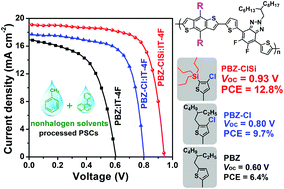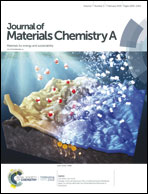Nonhalogen solvent-processed polymer solar cells based on chlorine and trialkylsilyl substituted conjugated polymers achieve 12.8% efficiency†
Abstract
Fluorine and alkylsilyl substitutions are two important strategies to reduce the energy levels and increase the absorption coefficient and hole mobility of photovoltaic materials simultaneously. Similar to fluorination, chlorination can also induce the intermolecular non-covalent interactions of Cl–H/S/Cl. Moreover, because chlorine (Cl) atoms contain empty 3d orbitals that can hold π-electrons from the conjugated skeleton, chlorination can decrease the molecular HOMO level more effectively than fluorination. Herein, we developed two wide bandgap polymer donors PBZ-Cl and PBZ-ClSi based on the Cl atom, and combined the Cl atom and alkylsilyl substituted thienyl benzodithiophene (BDTT-Cl and BDTT-ClSi) as donor units, respectively. From the control polymer PBZ to PBZ-Cl and then to PBZ-ClSi, the polymers show a gradually reduced HOMO level, increased absorption coefficient and improved charge mobility. As a result, the PBZ-ClSi:IT-4F-based PSCs fabricated by the nonhalogen solvents achieved a high power conversion efficiency (PCE) of 12.8% with a high open-circuit voltage (Voc) of 0.93 V, short-circuit current density (Jsc) of 19.2 mA cm−2, fill factor (FF) of 71.5% and a low energy loss of 0.57 eV, while the PSCs based on PBZ and PBZ-Cl only obtained lower PCEs of 6.4% and 9.7%, respectively. The PCE of 12.8% is one of the highest values recorded for nonhalogen solvent-processed PSCs to date. The results indicate that the combination of Cl atoms and alkylsilyl substituents is a simple and effective method for designing high efficiency polymer photovoltaic materials.



 Please wait while we load your content...
Please wait while we load your content...